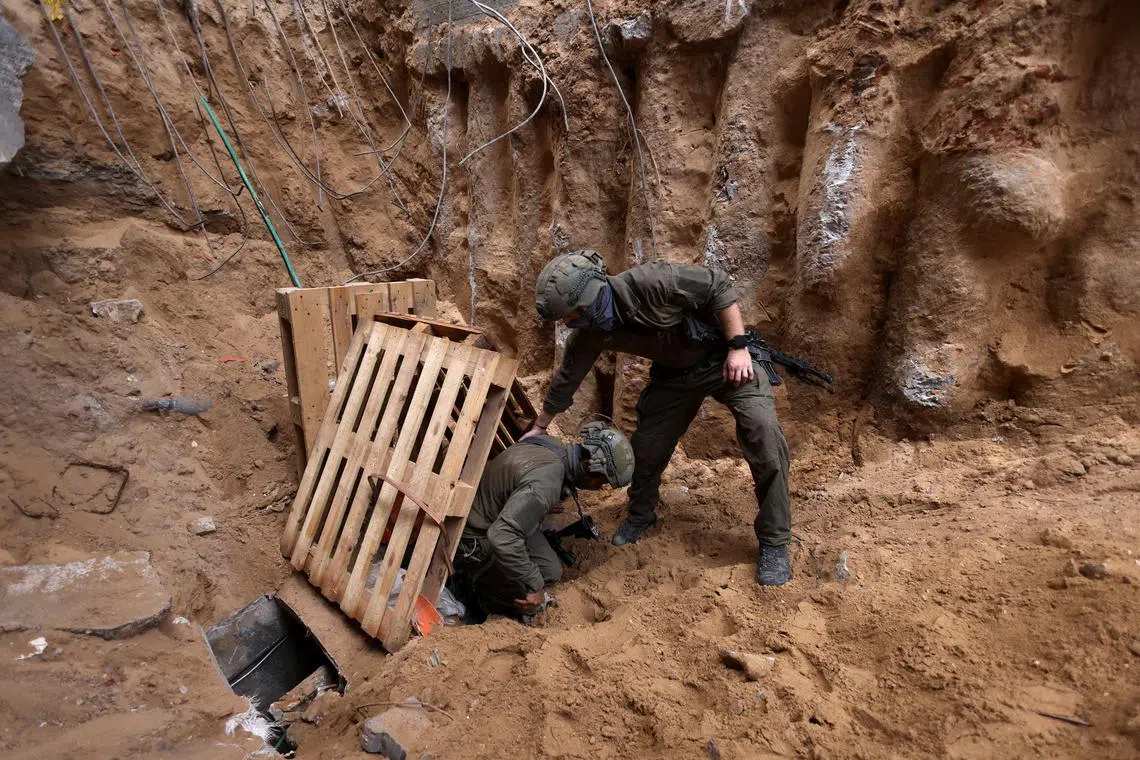Experts worried Israel could flood Gaza tunnels
Sign up now: Get ST's newsletters delivered to your inbox

Israeli soldiers at the opening to a tunnel at the Al-Shifa Hospital compound in Gaza City, in November 2023.
PHOTO: REUTERS
Follow topic:
JERUSALEM – Israel has reportedly started to test a plan to flood Hamas’ sprawling tunnel network, but experts say it is a dangerous option that poses huge risks to Gaza’s besieged civilians.
The military is determined to destroy the tunnels after Hamas’ Oct 7 attack in southern Israel,
AFP takes a look at Hamas’ tunnel network and Israel’s bid to destroy it.
‘Gaza metro’
Dubbed “the Gaza metro” by the Israeli military, there were 1,300 tunnels – adding up to a length of more than 500km – in Gaza at the start of the war in October, according to a study by US military academy West Point.
The maze of tunnels was initially used to bypass Israel’s devastating blockade on the Gaza Strip after Hamas came to power in 2007, allowing the smuggling of people, goods and weaponry in and out of Egypt.
It extended the network after the 2014 Israel-Hamas war and uses it to emerge across Gaza to launch rocket attacks on Israel.
Since Oct 7
Since entering Gaza in October, the Israeli military has found that the tunnel network is “even more extensive and deeper than they expected”, Dr Raphael Cohen, military expert with the US-based Rand Corp, told AFP.
The Israeli army said in December that it has found more than 800 tunnel shafts,
It claimed the shafts were in civilian areas of the densely populated territory, including schools, mosques and playgrounds.
In November, the army sparked an outcry when it stormed the Al-Shifa Hospital, claiming to have found a 55m tunnel in its basement.
Israel shared footage which it said proved hostages had been held there, which Hamas denied.
Hostages
Israel estimates that 250 people were taken as hostages into Gaza in the Oct 7 attack, which Israeli officials say killed about 1,200 people, mostly civilians.
Its retaliatory offensive has left much of Gaza in ruins and killed more than 18,700 people, mostly women and children, according to the Hamas-run Health Ministry.
Several of the 105 hostages freed during a week-long truce that ended on Dec 1 described being held captive in the tunnels.
Israeli army spokesman Daniel Hagari said on Dec 12 that the bodies of two hostages were found in the “underground infrastructure” in Gaza.
Destroying the tunnels
The Israeli army has not said exactly how it plans to destroy or block the tunnels in the small coastal territory.
But the Israeli media reports that the army is leaning towards flooding the tunnels with seawater pumped from the Mediterranean.
There have been successful tests, public broadcaster Channel 11 reported on Dec 14.
But Dr Cohen told AFP there are always “second-order consequences” with such tactics.
“There’s no good way of destroying a tunnel without affecting the infrastructure above ground,” he said.
Hamas doubts Israel’s ability to destroy the tunnels.
“Those tunnels were built by well-trained and educated engineers, and they have considered any kind of attacks that may happen, including bombing and water,” senior Lebanon-based Hamas official Osama Hamdan told a press conference on Dec 14.
Eco-hazard
The narrow Gaza Strip is only 6km to 12km wide, and the territory’s water tables were already facing a huge problem from becoming too salty, worsened by rising sea levels.
That adds to a chronically faulty wastewater system and the “uncontrolled used of pesticides and herbicides in intensive agricultural zones”, said Professor Eilon Adar from the Zuckerberg Institute for Water Research at Israel’s Ben-Gurion University of the Negev.
Combined, these factors have “had very serious consequences on Gaza’s water quality”, Prof Adar said. AFP

